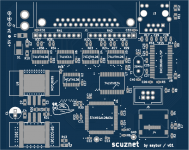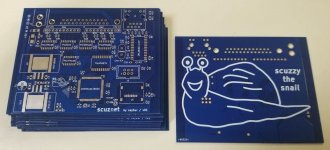-
Updated 2023-07-12: Hello, Guest! Welcome back, and be sure to check out this follow-up post about our outage a week or so ago.
You are using an out of date browser. It may not display this or other websites correctly.
You should upgrade or use an alternative browser.
You should upgrade or use an alternative browser.
SCSI to Ethernet Adapter on New Hardware
- Thread starter saybur
- Start date
uyjulian
Well-known member
Source code is already up, so you can manufacture your own. https://github.com/saybur/scuznetHave you made any more progress on this? This is a really great idea, and there are a ton of machines lacking easy access to Ethernet.
- Alex
aperezbios
Well-known member
Have you measured current consumption while idle and active? What's up with the dual-linear-regulator design? Seems odd, am I missing something?If anyone has questions or comments, please fire away. Thanks for reading!
Last edited by a moderator:
PotatoFi
Well-known member
So admittedly, I haven't read through this entire thread... but I just wanted to say WELL DONE! There is a huge need for this kind of hardware, I'm thrilled that you took on the task and figured it out. Amazing work. 10/10 am interested in getting a hot air station so I can do SMD work to make some of these.
I'll be following the thread closely!
I'll be following the thread closely!
uyjulian
Well-known member
Source code is up, so you can start manufacturing your own now. https://github.com/saybur/scuznetSo admittedly, I haven't read through this entire thread... but I just wanted to say WELL DONE! There is a huge need for this kind of hardware, I'm thrilled that you took on the task and figured it out. Amazing work. 10/10 am interested in getting a hot air station so I can do SMD work to make some of these.
I'll be following the thread closely!
aperezbios
Well-known member
I have a batch of Printed Circuit Boards on the way, if anyone would like one.
PotatoFi
Well-known member
Definitely would.I have a batch of Printed Circuit Boards on the way, if anyone would like one.
saybur
Well-known member
One is 2.63V for the terminator, and the other is 3.3V for everything else. These could probably be switching regulators rather than big old linears, but I'm not familiar with switching regulator design and I didn't want to mess with that as part of the project. The weird 2.63V voltage is used instead of the standard 2.85V on the terminator due to Digikey not stocking 110ohm 10-SIP bussed resistors, so I went with an alternate configuration using a lower voltage and more common 100ohm parts (this is supported as part of the spec, though I've never seen a device using it in the wild). It would be trivial to replace the two regulator adjust resistors and move to the standard 110ohm resistor packs if desired.Have you measured current consumption while idle and active? What's up with the dual-linear-regulator design? Seems odd, am I missing something?
Power consumption has not been measured, but it likely isn't all that high: figure ~100mA for the SD card, 180mA for Ethernet, and ~480mA for the terminator as the main power sinks. Keeping with the KISS philosophy on the power side, the regulators are oversized and have pads for extra heatsinks in case that was necessary, but during testing they barely got warmer than ambient air while outside the case.
If a reference would be of interest, I've added the BOM I used when making my boards to Github. That should more or less be accurate: I dropped the unnecessary 128A3U XMEGA part down to 64A3U, as the extra memories are not necessary for the firmware.
aperezbios
Well-known member
One is 2.63V for the terminator, and the other is 3.3V for everything else. These could probably be switching regulators rather than big old linears, but I'm not familiar with switching regulator design and I didn't want to mess with that as part of the project. The weird 2.63V voltage is used instead of the standard 2.85V on the terminator due to Digikey not stocking 110ohm 10-SIP bussed resistors, so I went with an alternate configuration using a lower voltage and more common 100ohm parts (this is supported as part of the spec, though I've never seen a device using it in the wild). It would be trivial to replace the two regulator adjust resistors and move to the standard 110ohm resistor packs if desired.
Power consumption has not been measured, but it likely isn't all that high: figure ~100mA for the SD card, 180mA for Ethernet, and ~480mA for the terminator as the main power sinks. Keeping with the KISS philosophy on the power side, the regulators are oversized and have pads for extra heatsinks in case that was necessary, but during testing they barely got warmer than ambient air while outside the case.
If a reference would be of interest, I've added the BOM I used when making my boards to Github. That should more or less be accurate: I dropped the unnecessary 128A3U XMEGA part down to 64A3U, as the extra memories are not necessary for the firmware.
I also found the TI REG710NA-2.7/250 which is a 2.7VDC out, 5V in, 30mA switching regulator, which is in the SOT-23-6 form factor, but it's about the same price as the LDO you're currently using.

techknight
Well-known member
I actually use the ATXmega128A1U in our product.
Sadly this chip even though powerful, is super sensitive to voltage glitches and flash erasure.
Mine has a bootloader so I can do software updates, Even with tons of filtering, and the BOD enabled continuously with the thresholds set it, every great once in awhile i find a device that is stuck in a bootloader reset cycle and flash memory erased. Its weird. Only reason why the bootloader remains is I have the fuses set to make it read/write locked.
Sadly this chip even though powerful, is super sensitive to voltage glitches and flash erasure.
Mine has a bootloader so I can do software updates, Even with tons of filtering, and the BOD enabled continuously with the thresholds set it, every great once in awhile i find a device that is stuck in a bootloader reset cycle and flash memory erased. Its weird. Only reason why the bootloader remains is I have the fuses set to make it read/write locked.
aperezbios
Well-known member
The PCBs are finally out for delivery today via DHL. I'll keep y'all updated.Definitely would.
PotatoFi
Well-known member
Let me guess... delayed by Chinese New Year and Coronavirus? I did a run of PCB's for a conference badge a few weeks ago, and at the last minute I had to do an emergency order from a Korean PCB manufacturer because my order from JLCPCB so delayed. It sounds like a lot of people have been affected by this.The PCBs are finally out for delivery today via DHL. I'll keep y'all updated.
Looking forward to seeing how they turn out!
That’s surprising, since I recently got an order from JLCPCB and they told me they weren’t experiencing any interruptions due to Coronavirus.Let me guess... delayed by Chinese New Year and Coronavirus? I did a run of PCB's for a conference badge a few weeks ago, and at the last minute I had to do an emergency order from a Korean PCB manufacturer because my order from JLCPCB so delayed. It sounds like a lot of people have been affected by this.
Looking forward to seeing how they turn out!
aperezbios
Well-known member
They're here, and rather than hijack this one further, I've started a new thread for it here. I'll be selling them with parts kitsLooking forward to seeing how they turn out!

saybur
Well-known member
I just pushed an update to Github that gets the speed to ~950kB/s on my modern desktop with an AVA-2906 host (originally it was more like ~550kB/s). Theoretical maximum with the microcontroller's CPU clock is probably something like 1.8MB/s, so there is still quite a bit of room for improvement.
Also, I'm also planning on getting mode information into the firmware to allow formatting and the like: Linux is not happy with this device not providing it, though AFAIK it isn't strictly required by the spec. There are also plenty of other bugfixes that likely need to be applied as well.
Also, I'm also planning on getting mode information into the firmware to allow formatting and the like: Linux is not happy with this device not providing it, though AFAIK it isn't strictly required by the spec. There are also plenty of other bugfixes that likely need to be applied as well.
saybur
Well-known member
I finally got enough additional commands implemented that a patched copy of HD SC 7.3.5 can format the emulated drive, which is so much nicer than having to pull the SD card and have to format it on a separate computer. I also did some more speed testing on my IIci and got ~1.25MB/s on reads and ~768kB/s on writes. The same computer also has an older SCSI2SD clone board, which averaged ~1.15MB/s read and ~1.00Mb/s write performance. Testing was done with 100-600K transfer sizes using SCSI Evaluator 1.07. I'd take these results with a grain of salt, and I'd be curious if anyone reading can verify similar SCSI2SD performance in a IIci.
Future plans include increasing write performance and seeing if any of these tweaks can be applied to the Ethernet controller as well. I also want to test this on a Plus and see if the thing works with the quirky SCSI implementation that computer has. I hope to get my Plus recapped in some free time coming up, and I'll see what that testing shows.
Future plans include increasing write performance and seeing if any of these tweaks can be applied to the Ethernet controller as well. I also want to test this on a Plus and see if the thing works with the quirky SCSI implementation that computer has. I hope to get my Plus recapped in some free time coming up, and I'll see what that testing shows.
landoGriffin
Well-known member
I ordered a few of these boards to check out. Do you have any suggestions for a low cost programmer? It looks to me that the Pocket AVR programmer from sparkfun should work. Am I missing anything major?
https://www.sparkfun.com/products/9825
Or, it appears I might be able to just use the GPIO pins from a Raspberry Pi too.... https://learn.adafruit.com/program-an-avr-or-arduino-using-raspberry-pi-gpio-pins/overview
Any suggestions?
I'm looking forward to getting my parts and checking this out!
https://www.sparkfun.com/products/9825
Or, it appears I might be able to just use the GPIO pins from a Raspberry Pi too.... https://learn.adafruit.com/program-an-avr-or-arduino-using-raspberry-pi-gpio-pins/overview
Any suggestions?
I'm looking forward to getting my parts and checking this out!
saybur
Well-known member
I personally use and like the Olimex AVR-ISP-MK2, a clone of the real AVRISP mkII. Mouser and Digikey have it for ~$24 and it is useful across the main 8-bit AVR line: it does ISP for regular AVRs and PDI for Xmegas like on this board (though not UPDI on the new mega0/tiny1 chips). Most of the tutorials out there are for the standard AVRs using ISP, but I did see a Raspberry Pi program for PDI here:
https://github.com/DiUS/xmega-pdi-pi2
It looks like it hasn't been updated in a while though.
https://github.com/DiUS/xmega-pdi-pi2
It looks like it hasn't been updated in a while though.
landoGriffin
Well-known member
Similar threads
- Replies
- 99
- Views
- 11K
- Replies
- 24
- Views
- 2K
